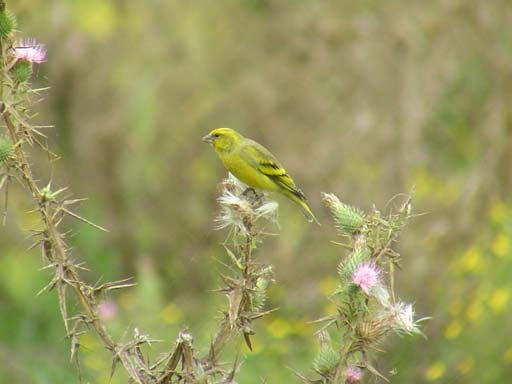- Serinus canicollis
Other Names
Yellow Crowned Canary; Deutsch: Kap Kanarienvogel; Afrikaans: Kaapse Kanarie
Description
The Cape Canary is 11-13 cm in length. The adult male of the southern races has a green back with black edging to the wing feathers wings and tail. The underparts, rump and tail sides are yellow, and lower belly is white. The rear head and neck are grey, and the face is cinnamon. The female is similar, but with a less grey on the head. The juvenile has greenish-yellow underparts with heavy brown streaking. This species is easily distinguished from the Yellow-fronted Canary by its lack of black face markings.
Distribution
South-eastern southern Africa. Highlands from Eritrea to Malawi. Highlands of western Angola.
Taxonomy
Six subspecies are recognised by Fry and Kieth (2004):
S. c. canicollis; south-western Cape to western Free State and southern KwaZulu-Natal. S. c. thompsonae; Lesotho, eastern Free State and northern KwaZulu-Natal to Limpopo Province. S. c. griseitergum; eastern Zimbabwe and adjacent Mozambique highlands. S. c. flavivertex; Eritrea to northern Tanzania. S. c. sassi; south-western Uganda, eastern Zaire, southern Tanzania, northern Malawi and north-eastern Zambia. S. c. huillensis; highlands of western Angola. Fry and Kieth (2004), Sinclair and Ryan (2003) and Hockey Dean Ryan and Maree (2005) consider the three northern races a separate species (Serinus flavivertex, Yellow-crowned Canary). They are brighter yellow below, have no grey on the head, and have black and yellow rather than olive green and yellow wings (Photo left).
Habitat
Scrub and grasslands with trees, copses, plantations, gardens, parks, road verges, croplands, orchards, fybos, montane grasslands. Most common in highland areas, but is found in coatal bush in South Africa.
Behaviour
Occurs singly, in pairs, or in flocks of up to 500. Forages for seeds on ground, and in scrub, weeds, and trees.
Reproduction
It builds a compact cup nest, commonly in a shrub.





